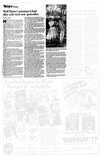Last of five parts
MOVIE CRITICS, many of whom had deprecated the postwar Disney films, devoted columns of praise to "Mary Poppins." Although he claimed to be indifferent, Walt Disney could not conceal his pleasure. The box office figures mounted astonishingly, and in its first release "Mary Poppins" amassed worldwide rentals of $14 million. Disney was delighted when the film drew 13 Academy Award nominations; it was the first time a Disney movie had contended in the leading categories.
Honors continued to shower on Disney. The highest came on Sept. 14,.1964, when President Johnson presented him with the Medal of Freedom at the White House. The citation: "Artist and impresario, in the course of entertaining an age, Walt Disney has created an American folklore."
Disney's accomplishments impressed even his own grandchildren. He delighted in telling about the time he and wife Lilly were baby-sitting when a thunderstorm struck during the night. The children came scrambling to the grandparents' bed, and one pleaded after a clap of thunder, "Turn it off, Grandpa."
Disney's opposition to a second Disneyland weakened as his organization matured. He saw the chance of doing more than just the duplication of a theme park. He concluded that another Disneyland could be used to accomplish his greater goal: planning and building a city that would show how people could live in a clean, handsome, and stimulating community.
DISNEY SET UP a planning committee. Throughout, he concerned himself with the overall concept of the project and the design of the city of tomorrow, paying scant attention to the theme park. He asked his planners, "If you were going to build another Disneyland, how would you do it?" They said they would built it exactly as before. That confirmed Disney's belief that he should concentrate on the city of tomorrow.
Disney needed a name for his future city. One day at lunch he mused, "What we're talking about is an experimental prototype community of tomorrow. What does that spell? E-p-c-o-t. EPCOT. That's what we'll call it: EPCOT."
On New Year's Day, 1966, Disney was Grand Marshal of the Tournament of Roses parade in Pasadena. To the generation who had seen him weekly on his television series, he seemed little different. The same straight hair and trimmed mustache – perhaps a little grayer – and the same wide grin and upraised eyebrow.
He had passed his 64th year in December, and his once limitless energies were beginning to flag. More and more he complained that he was feeling "gimpy" and that the day's activities left him "pooped."
After the dedication of the New Orleans Square at Disneyland on July 24, he entered the UCLA Medical Center for tests. X-rays showed that calcification of an old neck injury had increased; an operation could help relieve the condition. He decided to wait until after the end of the year.
[…]
